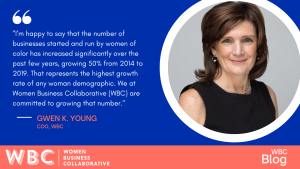
As we draw to the end of Black History month, I’d like to focus on an area of potential growth and opportunity: Women of Color Entrepreneurship.
I’m happy to say that the number of businesses started and run by women of color has increased significantly over the past few years, growing 50% from 2014 to 2019. That represents the highest growth rate of any woman demographic.
We at Women Business Collaborative (WBC) are committed to growing that number. Key to our efforts is the Women Entrepreneurs and Access to Capital Group which is laser focused on increasing both the number of businesses owned by women of color and their revenues. Each partner organization actively seeks out and supports initiatives to accelerate growth and increase access to capital for women founders of color.
Capital—A Major Stumbling Block for Women of Color Entrepreneurs
For women of color, acquiring capital is a major stumbling block to starting and growing a business. Women of color are founding businesses at a faster rate than women in general: 42% of newly created women-owned businesses are started by black women and 31% by Latinx women. Yet only 4% of woman founders who raised equity financing were black and only 2% were Latinx.
A number of factors come into play on why businesses run by women of color are under-capitalized:
Challenges stemming from the women themselves:
- Women of color often have an understandable fear of losing control resulting in a “Do it all myself” mindset and an accompanying resistance to raising capital.
- Women of color are often not schooled in the “why’s, when’s and how’s” of seeking and using capital. Additionally, they tend not to have the networks and allies to help them navigate that path.
- When turned down for funding, women of color often do not look to the reasons why or how to re-assess and re-group for a second go around.
Challenges stemming from “the system:”
- According to HBR, 96% of institutional assets under management are controlled by men. Evidence shows women portfolio managers are significantly stronger advocates for diverse entrepreneurship.
- Women of color tend to be asked different questions when seeking capitalization. They are more likely to be questioned about their past, while men tend to be asked about their vision for the future.
- There is a lack of resources for women of color to learn about types of capital, what they will need and how to use it when they get it.
- Unconscious bias remains prevalent, especially heightened by the lack of women portfolio managers.
Attacking the Capital Challenge Head On
WBC does not see these challenges as insurmountable and has put into place concrete, measurable goals for the next few years:
- 20% increase in women-owned businesses generating $5 million or more by 2025.
- 25% increase in average revenues for minority women-owned firms by 2025.
- A doubling of the percentage of venture capital available to women founders by 2025 from 2.3% in 2018.
Of course, the big question is: “How?” A number of actions and initiatives aimed at both women of color and venture capitalists can help us achieve these goals and more.
- Women of color need to gain a firm grasp on the need for and the power of venture capital. To that end, WBC has collaborated with partner organizations to create a series of webinars “Fundamentals of Capital” to help women understand the workings of capital and how and when to use it.
- Funders need to provide accessible resources that women of color can easily tap to learn where and how to get capital. One outstanding example is Bank of America’s on-line “Women Capital Directory,” which includes a special section for women entrepreneurs.
- Both successful women entrepreneurs and venture capitalists must work together to change the current lending environment so women of color can more easily scale their businesses. A key requirement is increasing the number of women lenders.
- Across the playing field, including lenders and lawmakers, a greater understanding of minority demographics is needed. We must get beyond a “one size fits all” mentality to lending. For example, a clearer appreciation for the requirements of microbusinesses would be especially impactful for women of color founders.
As Black History Month comes to an end, may it mark the beginning of continual strides for women of color entrepreneurs, those who have already started their companies and those looking to get under way.
WBC will work tirelessly to make that happen!
Gwen K. Young
COO, WBC



